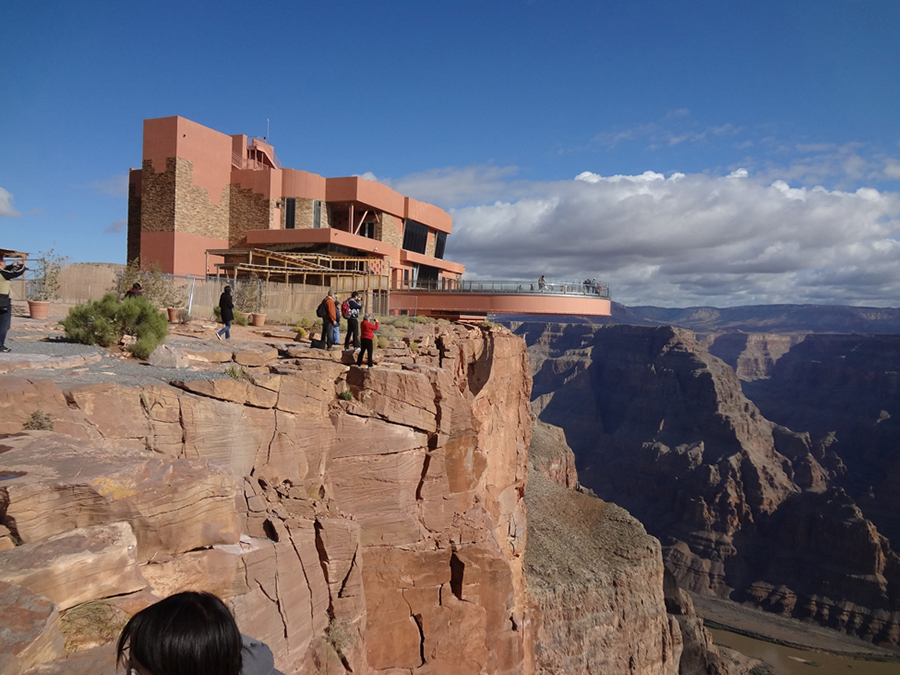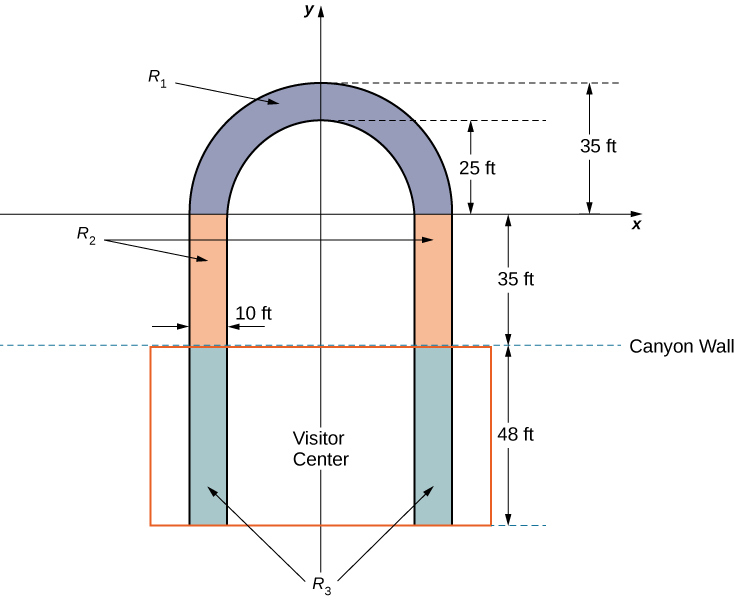- Find the balance point (center of mass) of straight objects and flat surfaces
- Utilize a shape’s symmetry to find the centroid, or geometric center, of flat objects
- Use Pappus’s theorem to calculate the volume of an object
Engineering The Grand Canyon Skywalk
The Grand Canyon Skywalk opened to the public on March 28, 2007. This engineering marvel is a horseshoe-shaped observation platform suspended [latex]4000[/latex] ft above the Colorado River on the West Rim of the Grand Canyon. Its crystal-clear glass floor allows stunning views of the canyon below (see the following figure).

The Skywalk is a cantilever design, meaning that the observation platform extends over the rim of the canyon, with no visible means of support below it. Despite the lack of visible support posts or struts, cantilever structures are engineered to be very stable and the Skywalk is no exception. The observation platform is attached firmly to support posts that extend [latex]46[/latex] ft down into bedrock. The structure was built to withstand [latex]100[/latex]-mph winds and an [latex]8.0[/latex]-magnitude earthquake within [latex]50[/latex] mi, and is capable of supporting more than [latex]70,000,000[/latex] lb.
One factor affecting the stability of the Skywalk is the center of gravity of the structure. We are going to calculate the center of gravity of the Skywalk, and examine how the center of gravity changes when tourists walk out onto the observation platform.
The observation platform is U-shaped. The legs of the U are [latex]10[/latex] ft wide and begin on land, under the visitors’ center, [latex]48[/latex] ft from the edge of the canyon. The platform extends [latex]70[/latex] ft over the edge of the canyon.
To calculate the center of mass of the structure, we treat it as a lamina and use a two-dimensional region in the [latex]xy[/latex]-plane to represent the platform. We begin by dividing the region into three subregions so we can consider each subregion separately. The first region, denoted [latex]{R}_{1},[/latex] consists of the curved part of the U. We model [latex]{R}_{1}[/latex] as a semicircular annulus, with inner radius [latex]25[/latex] ft and outer radius [latex]35[/latex] ft, centered at the origin (see the following figure).

The legs of the platform, extending [latex]35[/latex] ft between [latex]{R}_{1}[/latex] and the canyon wall, comprise the second sub-region, [latex]{R}_{2}.[/latex] Last, the ends of the legs, which extend [latex]48[/latex] ft under the visitor center, comprise the third sub-region, [latex]{R}_{3}.[/latex] Assume the density of the lamina is constant and assume the total weight of the platform is [latex]1,200,000[/latex] lb (not including the weight of the visitor center; we will consider that later). Use [latex]g=32{\text{ft/sec}}^{2}.[/latex]
- Compute the area of each of the three sub-regions. Note that the areas of regions [latex]{R}_{2}[/latex] and [latex]{R}_{3}[/latex] should include the areas of the legs only, not the open space between them. Round answers to the nearest square foot.
- Determine the mass associated with each of the three sub-regions.
- Calculate the center of mass of each of the three sub-regions.
- Now, treat each of the three sub-regions as a point mass located at the center of mass of the corresponding sub-region. Using this representation, calculate the center of mass of the entire platform.
- Assume the visitor center weighs [latex]2,200,000[/latex] lb, with a center of mass corresponding to the center of mass of [latex]{R}_{3}.[/latex] Treating the visitor center as a point mass, recalculate the center of mass of the system. How does the center of mass change?